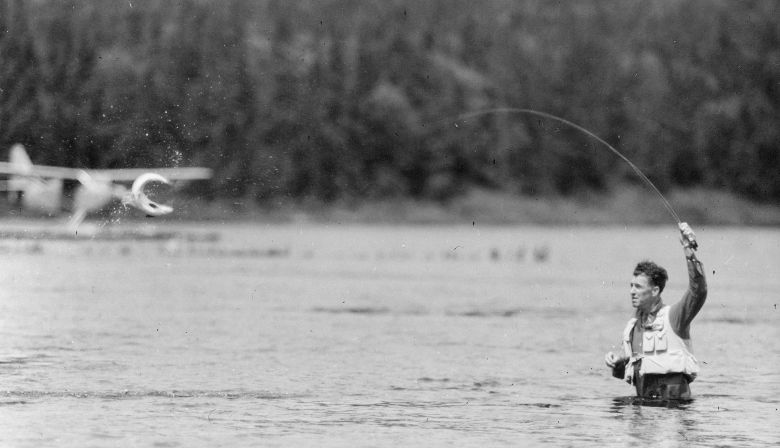
Subscribe & stay up-to-date with ASF


As summer intensifies, our rivers heat up and fish start to seek refuge in cooler pockets. During this time, it’s essential to handle them with utmost care when fishing. Please take a few moments to educate yourself about best fish handling practices and share this link with both novice and experienced anglers alike. Learn more at: https://www.keepfishwet.org/ »
–
“Over the entire length of the river, from top to bottom, salmon are found lying in places that are not pools but that happen to please an individual fish. It was a dream river, my Portland Creek, where a dozen of my sports could each have a separate and adequate stretch of water to fish – all within less than a mile of their cabin.” – Lee Wulff
At Portland Creek, while most tangible memories of Lee Wulff have faded with time – an expected outcome given the non-treated softwood construction of his cabins – his spirit endures.
As I drove up Route 430 on Newfoundland’s west coast, passing landmarks frequently mentioned in Lee’s writings, like Cow’s Head, Western Brook Gorge, and Parson’s Pond, I imagined the countless times Lee flew just a few hundred feet overhead in his fabric-winged J-3 Cub, traveling roughly at my speed. How many awe-inspiring sights did he witness during an era when whales, caribou, and salmon flourished? The privilege I’ve had to trace his steps weighed heavily on me.
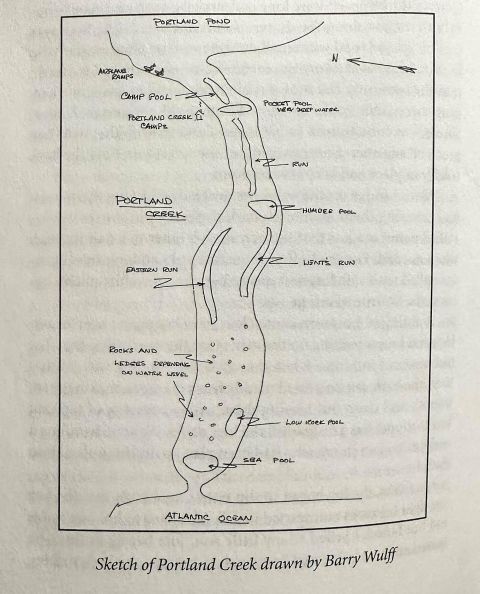
An hour and a half north of Rocky Harbour is the turn-off for Mountain Waters Resort, which sits where Portland Pond becomes Portland Creek, once the location of Lee’s camps. From the beginning of my journey, this site was a highlight on my itinerary. Rod Brophy, the head guide at Mountain Waters, had heard I was around and invited me to chat one afternoon while his clients lunched. Arriving on an unusually hot August day, I met Rod, fellow guide Coby, and others, taking a break on the shore overlooking a beautiful stretch of river, perfect for wading and littered with taking water.
Newfoundland was experiencing a heatwave, and as the guiding season neared its end, the guests at the resort were their last for the year. The guides, sunburned and fatigued from a long season, looked spent.
As I approached Rod and sat down on an Adirondack chair next to him, his first question to me was, “What’s going on, Peter? Where are all the fish?” The salmon fishing season in Newfoundland had been dismal by all accounts. Locals told me it was perhaps the worst they’ve ever seen. Just a week earlier, Dan Chaisson had expressed similar sentiments at Harry’s River while lamenting the emptiness of Ledge Pool, usually home to a hundred fish this time of year. This observation, while anecdotal, was consistent everywhere I went.
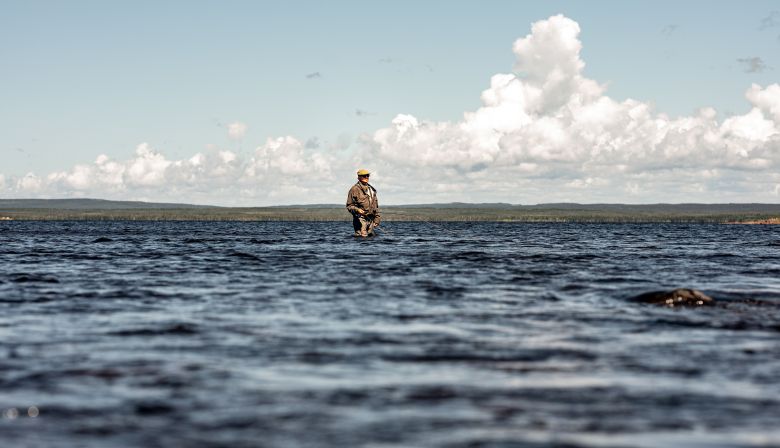
While I couldn’t provide a concrete answer to Rod’s question, I shared that the waters around Newfoundland and Labrador were undergoing changes; the water temperatures in Grand Banks are 5 degrees Celsius warmer than normal. I’d heard of unexpectedly high fish returns in the Margaree River, a typically autumn-centric location, and I suspected an increase in inland and marine poaching during the pandemic. Rod echoed this, mentioning a promising early season because of rains that seemed to vanish, leaving many anglers empty-handed. He worried about the future of his business if these trends persisted.
I regretted not having answers for Rod, the complex challenges faced by salmon mean that clear explanations are elusive. If we at ASF had all these answers, our tasks would surely be simpler. Nonetheless, Rod’s query spurred me to seek insights from Jon Carr, our Vice President of Research and Environment. To prepare for this, I invite you all to suggest and submit questions, and I promise to address as many of them as possible in a future RN. Your questions and insights will be invaluable.
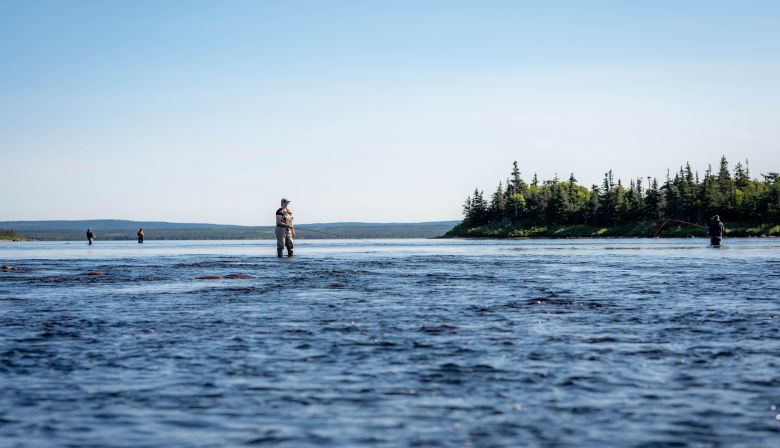
How has the season been in your region? Are you hearing of abundant returns, or is the news bleak? Please share any environment-related concerns you’d like me to discuss with Jon. I’ll do my utmost to address as many of your queries as possible.
Thank you for being part of the Rivernotes community and tuning in each week as I navigate the stunning, rugged landscapes of salmon country. As always, share the Rivernotes blog with friends who might appreciate these stories. Each share and gift given becomes a ripple that could spark a wave of change.
Please consider contributing to ASF, HERE.
Also, I love hearing from you all, especially those of you who challenge me to do a better job! Please, always feel encouraged to reach out directly to Rivernotes@asf.ca or Pdore@asf.ca with comments, questions, or concerns!
Until next week, stay sharp, and tight lines!
Peter
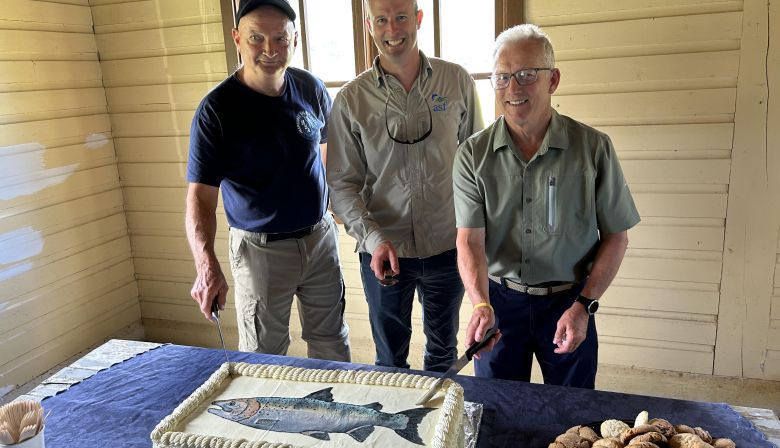
Kristen Noel and Peter Dore from ASF Communications and Marketing, report:
Wild Salmon Watersheds is a new freshwater Atlantic salmon conservation program created by ASF. Through Wild Salmon Watersheds, ASF will provide funding and resources to our partners for long-term conservation projects in watersheds where wild Atlantic salmon populations are relatively healthy. ASF’s goal is to establish 30 Wild Salmon Watersheds distributed throughout Eastern Canada by 2050. The Margaree and Cheticamp rivers in Cape Breton have been selected along with the Terra Nova River on the island of Newfoundland and the Nepisiguit River in New Brunswick as the first Wild Salmon Watersheds in Canada.
I had the pleasure of travelling up to Cheticamp last week to take in the Wild Salmon Watersheds program launch celebrating the Cheticamp and Margaree Rivers. The sun was shining, and it was a beautiful day to gather alongside about 50 partners and friends in the Cape Breton Highlands National Park. Wild Salmon Watershed partners from the Cheticamp River Salmon Association and the Margaree Salmon Association took to the microphone to talk about how the program will help support their ongoing projects.
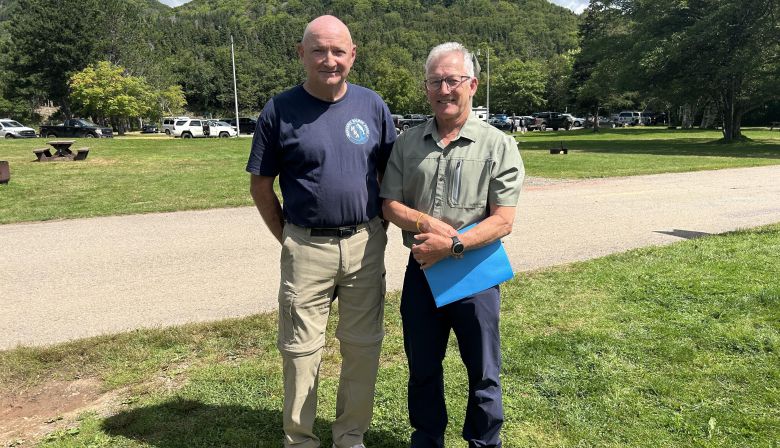
“For over 40 years, the Margaree Salmon Association has worked hard to protect salmon in our watershed. We are excited to join the Cheticamp River Salmon Association and partner with ASF to take a more long-term approach to our planning,” said Paul MacNeil, President of the Margaree Salmon Association.
After speeches and some mingling, we indulged in a delicious chocolate cake adorned with a beautiful (edible) painting of a salmon. We concluded the event by taking a walk down to the Cheticamp River, learning about some of the projects happening on the river, and reflecting in nature. Before starting my 5-hour drive home to the Annapolis Valley, I couldn’t resist ending the day with a quick dip in the mouth of the Cheticamp River alongside other ASF staff!
– Kristen

Returning to the Terra Nova and reuniting with familiar faces was a heartwarming experience. Notable figures with whom I’d had the pleasure of exploring the upper river earlier in the season, such as John Baird, Devin Bath, and John Lane from FABEC, as well as Kris Hunter and Don Ivany from ASF, graced the event on a splendid day. Alongside many locals, we gathered to witness the official inauguration of our Wild Salmon Watersheds program.
Kris and Don initiated the proceedings by introducing the program. John Baird stepped up to emphasize the significance of the collaboration: « The alliance between ASF and FABEC is a promising future for conservation. This partnership grants us the capability to achieve numerous objectives that previously seemed out of reach. I extend my thanks to Kris Hunter for his dedication and the teamwork he’s championed. »
The event was not just about formalities but also about community engagement. A group of enthusiastic young volunteers were honored with ASF memberships. Moreover, they, along with other attendees, enjoyed hands-on fly casting lessons. The entire atmosphere was charged with optimism, and it was evident that the community felt inspired and hopeful about the positive messaging being made towards salmon conservation.
– Peter
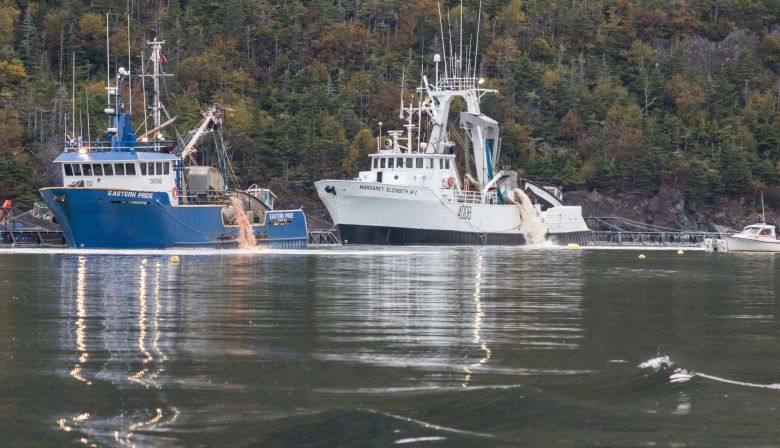
For wild Atlantic salmon, the stakes are incredibly high. Aquaculture salmon escape all the time and can interbreed with wild fish. These hybrid offspring can’t cut it in the wild. The result is population decline and collapse.
Right now the world’s biggest salmon aquaculture company, Mowi, is trying to add new cages and 2.2 million more salmon to the waters off the south coast of Newfoundland. ASF is saying hold on – the company hasn’t even had to complete a full environmental assessment.
We need our Rivernotes readers, especially people in Newfoundland and Labrador to help us tell the provincial government this is not OK.
Click here to send a letter before September 13th: https://www.asf.ca/news-and-magazine/salmon-news/no-expansion-for-the-open-net-pen-salmon-aquaculture-industry
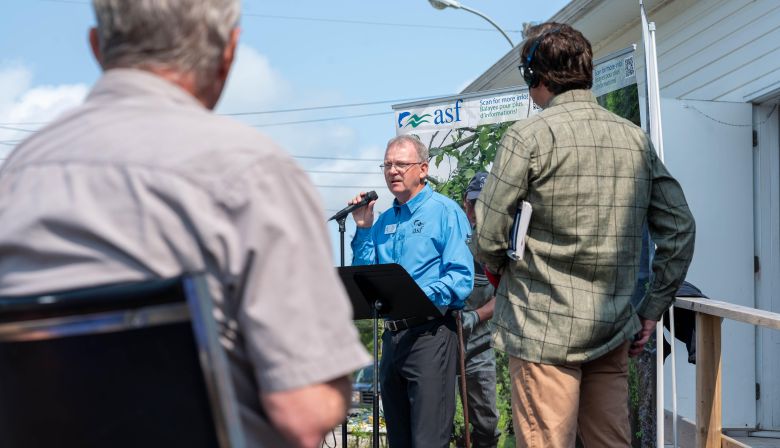
Don Ivany, Newfoundland and Labrador Program Director, reports:
The salmon fishing season in Newfoundland and Labrador (NL) is nearing its end, and it’s evident that this year’s salmon returns to our rivers are lower than last year’s at this same time. For detailed fishway counts to August 20th, refer to DFO’s link.
Most rivers, aside from those in Western Newfoundland and a few in Labrador, have been facing low water levels with daytime temperatures between 18-22°C. These conditions made fishing tough for the avid anglers still trying, with only a few fish spotted entering our rivers. If the conditions don’t change, any new salmon may not venture into the rivers until September or later. Given that DFO generally closes counting facilities by August’s end, it might be prudent for anglers to urge the DFO to extend their counting and enforcement operations until September’s end, given similar extensions last year.
Recent reports indicate mixed results across NL. The West coast experienced a boost from rains, leading to improved fishing conditions in places like Harry’s River. However, other regions, such as Bay St. George and Central Newfoundland, had fewer successes, attributed mainly to warm water temperatures. Reports from the Gander River were more positive, and both Southcoast and Avalon Peninsula regions experienced slow fishing. Nonetheless, expected heavy rains might improve conditions in the coming days.
Last week was significant for the Atlantic Salmon Federation (ASF) and me. Together with my colleagues, Kris Hunter and Peter Dore, we launched ASF’s Wild Salmon Watersheds Program on the Terra Nova River, in collaboration with the Freshwater Alexander Bays Ecosystem Corporation (FABEC). This event, which I had the honor of hosting, was well-attended by the public, community representatives, and partners. After a welcome and program overview, a ceremonial cake cutting marked our partnership’s commencement. Attendees enjoyed a free barbecue, fly casting lessons, and a guided nature walk along the Terra Nova River. The event also gained significant media attention. Given the positive feedback, the launch of ASF’s Wild Salmon Watersheds Program in partnership with FABEC was undoubtedly successful!

Charles Cusson, Quebec Program Director, reports:
Read the Full Report Complete with Fish Counts, Here. Lisez le rapport complet avec les comptes de poissons, ici.
The month of August 2023 benefits anglers with two full moons. The next one on August 31st, commonly known as the “Blue Moon,” is a special phenomenon. The start will take place at sunset and will end in the early morning of September 1st. The next will be on May 31, 2026.
If there are any salmon that have been reluctant to access their native river recently, the high tides hopefully will make it easier for them. If you observe a new run of salmon during the Labour Day weekend, please share with us.
Good fishing and Tight Lines!
Reminder to salmon anglers fishing the rivers of Quebec, take the time to declare your catches and releases, the managers will be very much obliged.
** The data used in this report comes from various websites, social media, and Quebec government sources.
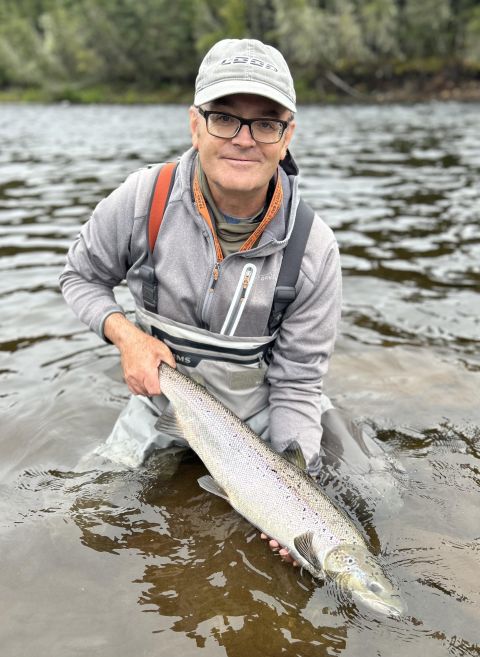
Le mois d’aout 2023 et les adeptes de la pêche au saumon bénéficient de deux pleines lunes, celle du 31 aout, communément connue sous le nom de « Lune bleue » est un phénomène spécial. Le début aura lieu au coucher du soleil et prendra fin au petit matin du 1er septembre. La prochaine se manifestera le 31 mai 2026.
S’il y a des saumons qui ont hésité d’accéder à leur rivière natale récemment, les marées hautes, on l’espère leur facilitera la tâche. Si vous observez une montaison pendant la fin de semaine du travail, veuillez svp le partager avec nous. Bonne pêche et Tight Lines !
** Les données utilisées dans ce rapport proviennent de divers sites Web, médias sociaux et des sources du gouvernement du Québec.
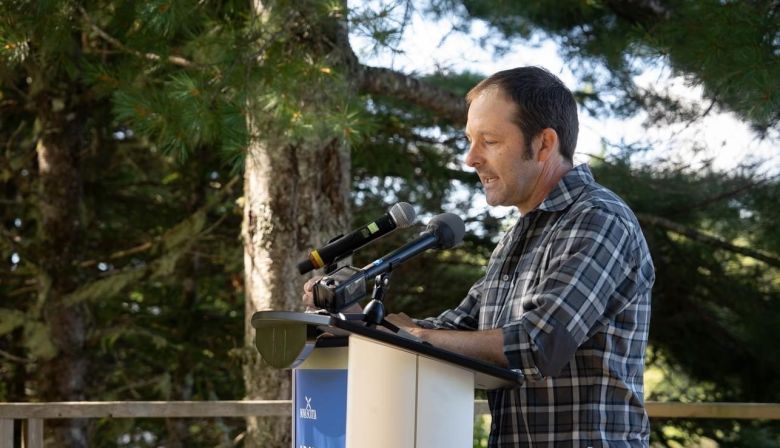
Deirdre Green, Nova Scotia Program Director, reports:
August’s wet and wild weather has set anglers up well for late summer fishing. With yet another recent flush of water, we continue to receive reports of fresh fish arriving daily in countless rivers. With these high-water conditions, we remain hopeful Hurricane Franklin does not wreak havoc on our communities.
Paddy Poirier, Margaree Salmon Association (MSA) Director, and fishing guide comments: This season has been phenomenal. Salmon runs started early and continue even now. Although we endured some terrifyingly low, warm water early on, conditions have been great since the beginning of August.
As a guide, I could not ask for a better season with excellent returns of salmon and many clients checking off their bucket list fish. Many fish were in the mid 20s and lots in the 15-18 pound range.
As autumn approaches, we are seeing bright silver fish and the more bronze toned fall fish full of sea lice. We have had some higher water conditions in what is typically a low, dry season. For Atlantic salmon, we could not ask for better conditions to ensure a safe return. As always, keep them wet.
Réné Aucoin, President of the Chéticamp River Salmon Association (CRSA) estimates that 550 salmon +/- 20% have returned to the Chéticamp this season. This is based upon informal angler surveys conducted by the CRSA and counting fence data from 1984-1989 where approximately 50% of the fish through the trap were hooked and released by anglers.
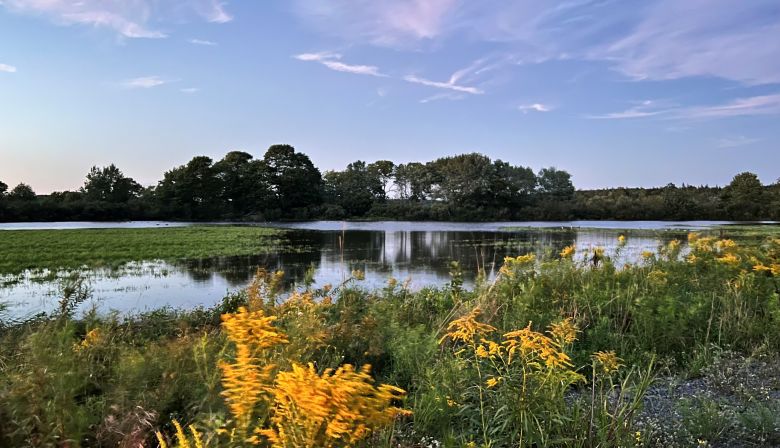
Réné shares:
Every fisherman I have spoken to says this season was well beyond last year, and the consensus is that 2023 was one of the best seasons since 1986. Interestingly, the highest count during the counting fence years was 1986 when 600 fish were counted. And this was with a few high-water days where the fence was not in operation and with no fall run fish counted.
The Chéticamp is not alone on Cape Breton Island, as reports indicate that both the North and Margaree Rivers had or are having exceptional years so this corroborates CRSA’s estimation. Réné adds:
Last fall, the October 2022 swim through count on Middle River (a similar size system to the Chéticamp) was 450+ from a low of 80 in 2021. This could be viewed as another corroboration of sorts, or at least evidence that the rivers flowing from the highlands have all had very good runs.
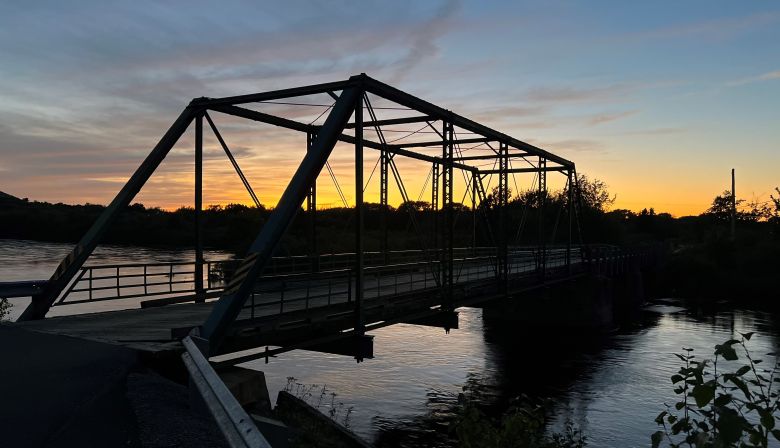
The Margaree has had dark, cool, fall-like water for several weeks. We seem to be between the summer and fall runs, but fresh fish are still hooked daily. There were plenty of salmon in the river this summer, like the exceptional runs of 1986, 1996 & 2010. Seems to be a pattern, but we do have a good run each season. With the rain we are expecting, we’re hoping for an early fall run.
Of course, while record summer rainfall is wonderful for the fish, it presents unique challenges for groups endeavoring to complete in-stream restoration work. Habitat biologist and consultant, Charles MacInnis shared: You need dry weather to set up at these sites and to get your gear and material in and you also need the comfort of knowing that in the middle of your project you’re not going to get 100mm of rain. This season we were not afforded either. The instability and unpredictability of the weather this season has made things difficult to say the least and has resulted in our having to delay projects. We remain optimistic as we still have all of September to get the work completed.

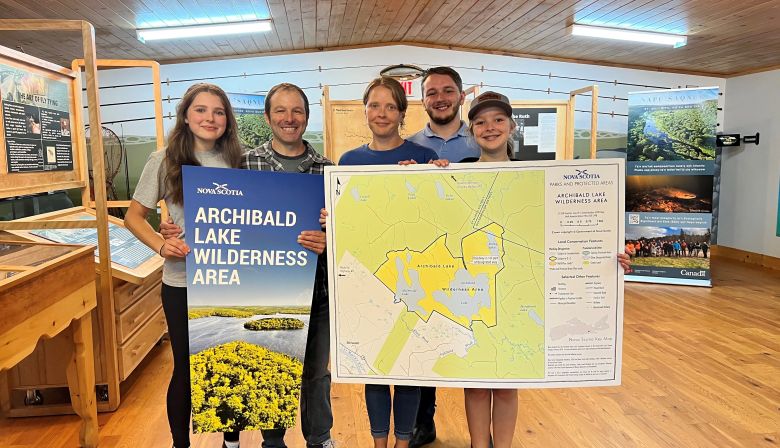
Exciting News for the St. Mary’s River and Atlantic salmon:
On Monday, the province of NS announced a new provincial wilderness area in Guysborough County, protecting a lake that has been eyed as a water source for proposed Cochrane Hill gold mine.
Agriculture Minister Greg Morrow stood on the main branch of the St. Mary’s River and announced that the Archibald Lake Wilderness Area will cover nearly 700 hectares of old-growth forest, lakes, and wetland. The area includes Archibald Lake, McDonald, and Rocky Lake, which feed into Archibald Brook, a major tributary of the St. Mary’s River.
This good news story for wild rivers and wild Atlantic salmon has garnered national media attention. Scott Beaver, President of the St. Mary’s River Association called Monday a « joyous day”. It really is one of the very first spots Atlantic salmon have, when they leave the estuary — the saltwater, the brackish water — and they move up the [river] waters and they hit the deep, cool refuge of Archibald Lake drainage basin. It’s so very important, Beaver told media.
As Minister Morrow noted: Our Land and our Water are among our provinces MOST valuable resources, providing multiple benefits for people and the economy. This announcement puts us one step closer to getting the St. Mary’s River and the wild Atlantic salmon who call it home, the protection they deserve.
Scott Beaver’s TV interview: https://www.cbc.ca/news/canada/nova-scotia/guysborough-county-archibald-lake-wilderness-area-1.6949475
Deirdre Green’s radio interview: https://www.cbc.ca/listen/live-radio/1-37/clip/16006218
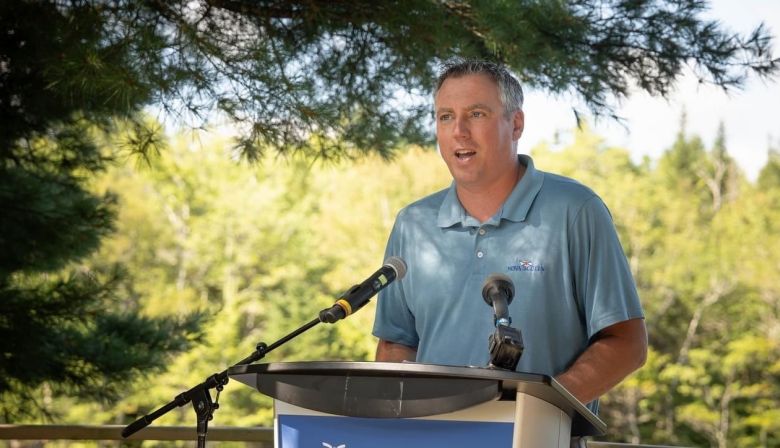
After a drive from the Mainland, we pull into Margaree Forks at six in the morning. We are greeted by cool, high water under a thick layer of low-lying fog. Arriving after a period of rain, conditions appear promising as we start our 2-day trip on the Margaree.
This is our second time on the river, and the impromptu nature of our trip left us without a guide. We pull our waders on, shrug our shoulders as we choose a muddler, a picasse and a Mickey Finn. We arbitrarily pick a less busy pool in the lower river.
As I walk upstream to rotate into the pool, my head turns to the tell-tale sound of zippering line on the surface and an excited shriek of “saumon”. My buddy is tight with a Margaree salmon after only 3 casts. After releasing an 8–10-pound fresh fish we start our second pass. Again, a fish inhales my friend’s picasse and after a few jumps the grilse comes undone. Blaming the lost fish on barbless hooks rather than user error, we depart from the pool for breakfast.
In between pools, we stop at the local fly shops to get some bugs and hopefully learn a bit about the river. Alex and Peter help us choose some regional flies and point us in the right direction. Both remarked how the water conditions are good compared to previous years and that the season is progressing very smoothly.
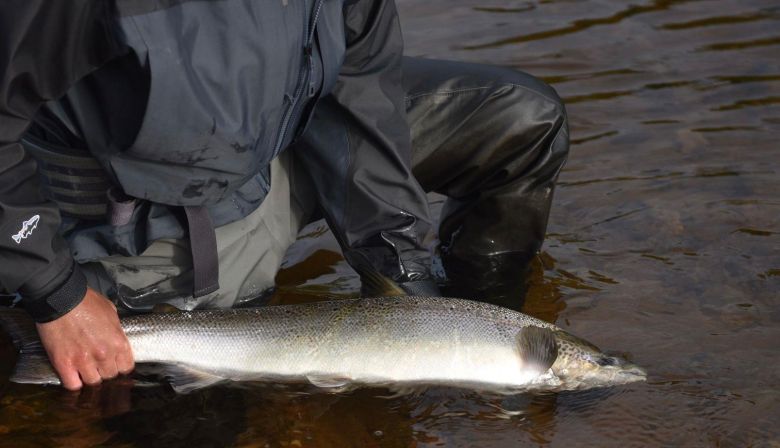
The following day the river is slightly lower and slower, so we choose a different location and opt for dry flies. Nearing the end of the pass, a salmon headbutts my fly. After a short rest, I send a second identical cast into the seam which drifts as the same snout breaks the surface and this time commits to the fly. After tailing the salmon, we grab a quick picture as it kicks away. Passing through the pool again I hook another fish but lose it.
Content with the morning, we decide to explore some upper-river pools. As we travel upstream, the changing makeup of the riverbed stands out. Most of the lower pools offer a slower uniform swing over smaller pebbles. Upstream, the marked pools are separated by rapids and pocket water that flow into faster-moving pools with large boulders. This gradient demands different fishing tactics from top to bottom.
After a rough drive upriver, we are glad to meet the paved Cabot Trail. We pack up in the parking lot of the Dancing Goat before grabbing a bite to eat and heading home. During the drive, we excitedly plan to return – the following week.
Thank you!
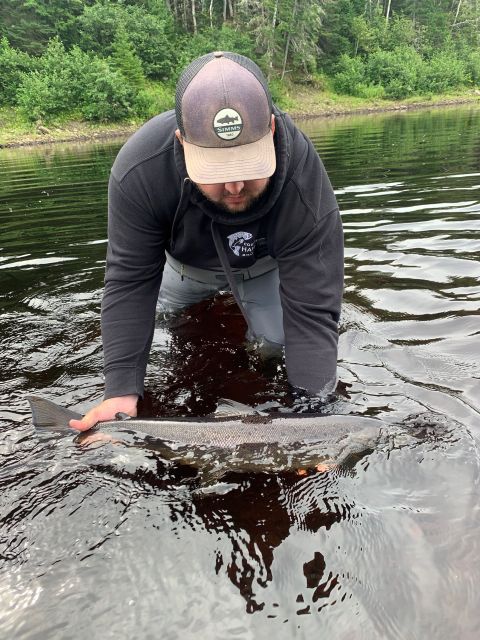
Serge Collin, New Brunswick Program Director, reports:
Click here to see updated numbers from the Dungarvon fish barrier!
Click here to see updated numbers from the NW Miramichi fish barrier!
August will probably end as it started, with lots of rain and high water, however, the last few days have been great water conditions, and have been putting anglers into some awesome fishing. Many have reported seeing mostly large salmon and very few grilse.
As we move into September, guides and anglers have already started using Fall flies, as this nice Cains River salmon was caught and landed by Colby Donovan using an Ally Shrimp.
See the updated report from the Penobscot, here!
See the updated report from the Kennebec here!
Tim Shaw shares a spotlight on Ducktrap River conservation:
In the heart of Midcoast Maine lies the Ducktrap River, one of the rivers in the state with an existing wild Atlantic salmon population. This river is more than just a water body; it’s a testament to community dedication and fervor for conserving natural habitats.
Over recent years, thanks to countless community partners, a significant portion of the Ducktrap watershed now benefits from conservation easements. The focus has evolved over time, and the past two years have been especially crucial. Considering the growing challenges of climate change, our efforts have been geared towards robust biological and environmental monitoring.
Interested in the specifics? Dive into our interactive StoryMap! It offers a detailed look into the eDNA (environmental DNA) study we spearheaded. This study was crucial in documenting the presence and specific locations of native Atlantic salmon and brook trout, as well as any invasive species that might threaten their habitats. Additionally, our summer water temperature monitoring program sheds light on critical cold water sources within the watershed, an invaluable asset for these species.
We believe that the methods and techniques we’ve employed could be immensely beneficial for other conservation initiatives. So, whether you’re an avid conservationist, a casual reader, or someone involved in similar endeavors, we invite you to explore and share our journey.
Check out the full story here.